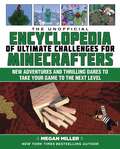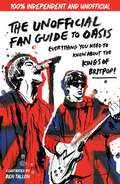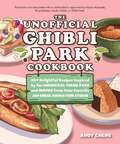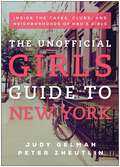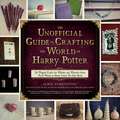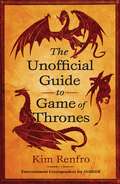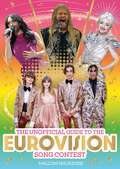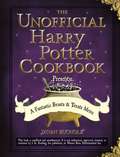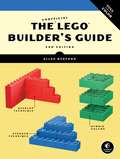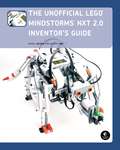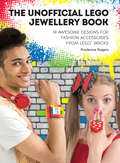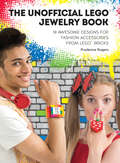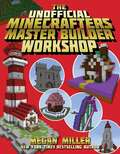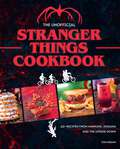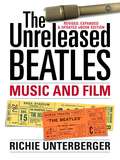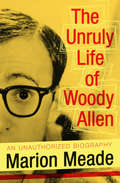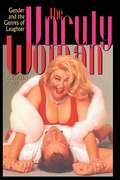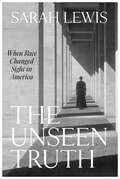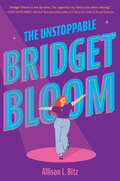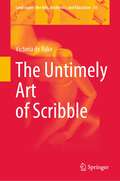- Table View
- List View
The Unofficial Encyclopedia of Ultimate Challenges for Minecrafters: New Adventures and Thrilling Dares to Take Your Game to the Next Level (Encyclopedia For Minecrafters Series)
by Megan MillerThe Minecraft universe is limitless. <P><P>You can explore as far as you like, build neverending castles, and battle hordes of monsters. But once you have your base, farms, weapons, and armor, what’s next? <P><P>When you're tired of the same old moves and you're hungry for new gameplay, The Unofficial Encyclopedia of Ultimate Challenges for Minecrafters will keep you busy with advanced maneuvers, thrilling new adventures, and extreme dares. You're not a true champion Minecrafter until you've . . . <P><P>Collected every mob in your own zoo Played the game King of the Ladder Completed every in-game advancement Defeated the Ender Dragon in hardcore mode Survived Survival Island Bested Ultra Hardcore PVE/PVP competitions And more! With hundreds of screenshots for easy visual reference and definitions of every term that might trip a player up, this exciting book covers the A to Z of exploring the infinite possibilities of Minecraft gameplay.
The Unofficial Fan Guide to Oasis: Everything you need to know before the 2025 tour!
by Eddie RobsonThe Unofficial Oasis Fan Guide tells the story of the most electric rock band in the world. Discover their rise to fame, how family drama interfered, the disastrous break up and everything there is to know about the reunion tour in this unofficial guide to Oasis.With profiles on all the band members (former and current), the history of Manchester's music scene, oasis songs to learn on the guitar, and everything we know about the 2025 tour, this is a must-have book for Oasis fans new and (not-so) old!
The Unofficial Fan Guide to Oasis: Everything you need to know before the 2025 tour!
by Eddie RobsonThe Unofficial Oasis Fan Guide tells the story of the most electric rock band in the world. Discover their rise to fame, how family drama interfered, the disastrous break up and everything there is to know about the reunion tour in this unofficial guide to Oasis.With profiles on all the band members (former and current), the history of Manchester's music scene, oasis songs to learn on the guitar, and everything we know about the 2025 tour, this is a must-have book for Oasis fans new and (not-so) old!
The Unofficial Ghibli Park Cookbook: 50+ Delightful Recipes Inspired by the Whimsical Theme Park and Movies from Your Favorite Japanese Animation Studio (Unofficial Studio Ghibli Books)
by Andy ChengBring even more magic into your kitchen with this unofficial collection of recipes straight from the heart of the Japanese theme park inspired by Hayao Miyazaki&’s most beloved films!Studio Ghibli has bewitched and delighted our hearts since 1985 with its enchanting stories featuring magic, love, nature, and, of course, the tastiest-looking animated food ever! In 2022, that captivating charm was brought to life with the opening of Ghibli Park, a theme park so exclusive that it has just one location in Japan and requires reservations made months in advance to enter. Why not prepare for your next visit to this wondrous place in your own kitchen? With more than 50 movie- and theme park–inspired recipes, The Unofficial Ghibli Park Cookbook contains a variety of tantalizing and unique dishes, including: Spicy Shrimp Sandwich On-The-Go Onigiri Bento Nabeyaki Udon Fish Bowl Fruit Punch Float Ketchup Spaghetti Sandwich Matcha Chiffon Cake Seasonal Fruit Pizza And more! A delightful window into the park itself, The Unofficial Ghibli Park Cookbook will take you on a culinary journey that honors Hayao Miyazaki&’s greatest works.
The Unofficial Girls Guide to New York: Inside the Cafes, Clubs, and Neighborhoods of HBO's Girls
by Judy Gelman Peter ZheutlinVisit Hannah, Marnie, Jessa, and Shoshanna's favorite haunts in The Unofficial Girls Guide to New York. More than just a travel guide, The Unofficial Girls Guide to New York delivers an in-depth look at Girls' physical and cultural landscape. Stop in at Café Grumpy and learn how to make a French press coffee the way Ray and Hannah would Go behind the scenes at Greenhouse, where Hannah and Elijah spend a night out, and meet &“iPad DJs" AndrewAndrew Recreate Jessa and Thomas-John's Foundry wedding cake, with buttercream icing made from local NYC rooftop honey Tour the Salmagundi Club, site of Hannah's cringeworthy reading and one of the city's oldest and most prestigious art and literary associations Shop Girls-style in the West Village, Nolita, and beyond Plus a lot more, from Greenpoint to Greenwich Village, and Bushwick warehouse parties to the Lower East Side gallery scene It's the best way to visit Girls' New York without paying for a plane ticket—or the perfect complement to your next trip. Featuring 18 maps, 21 recipes, and more than 100 full-color photos
The Unofficial Guide to Crafting the World of Harry Potter: 30 Magical Crafts for Witches and Wizards—from Pencil Wands to House Colors Tie-Dye Shirts
by Dinah Bucholz Jamie HarringtonCharming crafts even Muggles can make! You won't need alchemy or a magic wand to make these magical projects inspired by the world of Harry Potter. With a little Hogwarts creativity and the step-by-step guidance of this spellbinding book, you'll be able to transfigurate simple supplies and things around the house into everything from Remembrall Rings to Butterbeer Lip Balm to Nargles for your front lawn. You'll be as busy as Mrs. Weasley knitting her Christmas sweaters as you dive into dozens of Potterific projects. Relive the excitement of Harry's adventures with these genius crafts. Drop some homemade Pgymy Puff Bath Fizzies into the tub and pretend you're Moaning Myrtle. Keep memories of the Quidditch pitch close with your very own Golden Snitch Necklace. Or show off the Sorting Hat's selection with a House Colors Tie-Dye Shirt. Accio, crafting supplies--it's time for some wonderful wizardly fun!
The Unofficial Guide to Crafting the World of Harry Potter: 30 Magical Crafts for Witches and Wizards—from Pencil Wands to House Colors Tie-Dye Shirts
by Jamie HarringtonCharming crafts even Muggles can make! You won't need alchemy or a magic wand to make these magical projects inspired by the world of Harry Potter. With a little Hogwarts creativity and the step-by-step guidance of this spellbinding book, you'll be able to transfigurate simple supplies and things around the house into everything from Remembrall Rings to Butterbeer Lip Balm to Nargles for your front lawn. You'll be as busy as Mrs. Weasley knitting her Christmas sweaters as you dive into dozens of Potterific projects. Relive the excitement of Harry's adventures with these genius crafts. Drop some homemade Pgymy Puff Bath Fizzies into the tub and pretend you're Moaning Myrtle. Keep memories of the Quidditch pitch close with your very own Golden Snitch Necklace. Or show off the Sorting Hat's selection with a House Colors Tie-Dye Shirt. Accio, crafting supplies--it's time for some wonderful wizardly fun!
The Unofficial Guide to Game of Thrones
by Kim RenfroThe everything-you-missed, wanted-to-know-more-about, and can’t-get-enough guide to the Game of Thrones television series—from the first episode to the epic finale. Valar morghulis!Spanning every episode across all eight seasons, INSIDER’s entertainment correspondent Kim Renfro goes deep into how the show was made, why it became such a phenomenon and explores every detail you want to know. It’s the perfect book to look back at all you may have missed or to jump-start you on a second viewing of the whole series. As an entertainment correspondent, Renfro has covered the show’s premieres, broken down key details in scenes, explored characters’ histories, and interviewed the cast, directors, and crew. In this book, she sheds new light on the themes, storylines, character development, the meaning of the finale, and what you can expect next. Some of the questions answered here include: What was the Night King’s ultimate purpose? How did the show effect George R.R. Martin’s ability to finish the book series? Why were the final seasons shorter? Why did the direwolves get shortchanged? How were the fates of Jon Snow and Daenerys Targaryen foretold from the start? Was that really a bittersweet ending? Winter may have come and gone, but there is still plenty to discover and obsess over in this behind-the-scenes fan guide to the Game of Thrones HBO series.
The Unofficial Guide to the Eurovision Song Contest: The must-have guide for Eurovision 2023!
by Malcolm MackenzieThe must-have guide for Eurovision fans! Packed full of trivia, party games, high scores and nil points. Plus 32 pages of full colour photos.Hello, bonjour, Hola! It's Eurovision calling and what better way to celebrate the flamboyant show than with this ultimate (and unofficial) guide to the biggest singing contest in the world!How well do you know the Eurovision Song Contest? With this unofficial guide you'll know your Conchita Wurst's from your Alexander Rybanks, why we all love Kalush Orchestra, what made Sam Ryder the nation's sweetheart and which band takes top of the polls - Abba vs. Måneskin - or could it even be Scooch?This ultimate guide recaps the highs and lows of the decades old contest including its bangers and ballads, most shocking moments, photos of the worst dressed acts, top scoring countries - and those who score nil points, and plenty of games to play at your Eurovision party. Eurovision bingo anyone?
The Unofficial Harry Potter Cookbook Presents - A Fantastic Beasts & Treats Menu
by Dinah BucholzA Simon & Schuster eBook. Simon & Schuster has a great book for every reader.
The Unofficial LEGO Builder's Guide, 2nd Edition
by Allan BedfordWhat's the difference between a tile and a plate? Why isn't it a good idea to stack bricks in columns to make a wall? How do you build a LEGO mosaic or build at different scales? You’ll find the answers to these and other questions in The Unofficial LEGO Builder’s Guide.Now in full color, this brand-new edition of a well-loved favorite will show you how to:–Construct models that won't fall apart–Choose the right pieces and substitute when needed–Build to micro, jumbo, and miniland scale–Make playable board games out of LEGO pieces–Create photo mosaics and curved sculptures–Build a miniature space shuttle, a minifig-sized train station, and moreOf course, the real fun of LEGO building lies in creating your own models—from choosing the subject to clicking that final brick into place. Learn how in The Unofficial LEGO Builder’s Guide.Includes the Brickopedia, a visual dictionary of nearly 300 of the most commonly used LEGO elements!
The Unofficial LEGO MINDSTORMS NXT 2.0 Inventor's Guide
by David J. Perdue Laurens ValkThe LEGO® MINDSTORMS® NXT 2.0 set offers hundreds of building elements, programming software, and powerful electronics that you can use to create amazing robots. But where do you begin?This eagerly awaited second edition of the bestselling Unofficial LEGO MINDSTORMS NXT Inventor's Guide is your key to designing, building, and programming robots with the NXT 2.0 set.You'll learn practical building techniques, like how to build sturdy structures and use gears, and gain a solid understanding of the set's NXT-G programming language. A series of projects new to this edition offers step-by-step instructions for building and programming six robots, each of which can be built with just one NXT 2.0 set, including:–Inventor-Bot, a fast, simple, modular vehicle with treads–Sentry-Bot, a robot guard that shoots balls at intruders–Table-Bot, a vehicle that uses its antennae to avoid falling off a tabletop–The Jeep, a four-wheeled vehicle that avoids obstacles and follows lines–The Lizard, a large walking robot that uses the color sensor to detect and respond to different colored balls–The Printer, a stationary robot that uses a pen or marker to draw letters, words, and shapes on paperAdditional resources include the Piece Library, which contains basic information on the more than 80 types of LEGO pieces in the NXT 2.0 set, and the Quick Reference, which lists the 34 types of standard programming blocks.So go ahead. Grab your NXT 2.0 set, fire up your imagination, and see what you can invent with The Unofficial LEGO MINDSTORMS NXT 2.0 Inventor's Guide.
The Unofficial LEGO Technic Builder's Guide
by Pawel Sariel KmiecThe LEGO® Technic system opens a new realm of building possibilities. Using motors, gears, pneumatics, pulleys, linkages, and more, you can design LEGO models that really move.The Unofficial LEGO Technic Builder's Guide is filled with building tips for creating strong yet elegant machines and mechanisms with the Technic system. Author Pawe? "Sariel" Kmiec will teach you the foundations of LEGO Technic building, from simple machines to advanced mechanics, even explaining how to create realistic to-scale models. Sariel, a world-renowned LEGO Technic expert, offers unique insight into mechanical principles like torque, power translation, and gear ratios, all using Technic bricks.You'll learn how to:–Create sturdy connections that can withstand serious stress–Re-create specialized LEGO pieces like casings and u-joints, and build solutions like Schmidt and Oldham couplings, when no standard piece will do–Build custom differentials, suspensions, transmissions, and steering systems–Pick the right motor for the job—and transform its properties to suit your needs–Combine studfull and studless building styles for a stunning look–Create remote-controlled vehicles, lighting systems, motorized compressors, and pneumatic enginesThis beautifully illustrated, full-color book will inspire you with ideas for building amazing machines like tanks with suspended treads, supercars, cranes, bulldozers, and much more. Your Technic adventure starts now!
The Unofficial LEGO Technic Builder's Guide, 2nd Edition
by Pawel Sariel KmiecThis thoroughly updated second edition of the best-selling Unofficial LEGO Technic Builder’s Guide is filled with tips for building strong yet elegant machines and mechanisms with the LEGO Technic system. World-renowned builder Pawe? "Sariel" Kmiec covers the foundations of LEGO Technic building, from the concepts that underlie simple machines, like gears and linkages, to advanced mechanics, like differentials and steering systems. This edition adds 13 new building instructions and 4 completely new chapters on wheels, the RC system, planetary gearing, and 3D printing.You’ll get a hands-on introduction to fundamental mechanical concepts like torque, friction, and traction, as well as basic engineering principles like weight distribution, efficiency, and power transmission—all with the help of Technic pieces. You’ll even learn how Sariel builds his amazing tanks, trucks, and cars to scale.Learn how to:–Build sturdy connections that can withstand serious stress–Re-create specialized LEGO pieces, like casings and u-joints, and build custom, complex Schmidt and Oldham couplings–Create your own differentials, suspensions, transmissions, and steering systems–Pick the right motor for the job and transform it to suit your needs–Combine studfull and studless building styles for a stunning look–Build remote-controlled vehicles, lighting systems, motorized compressors, and pneumatic enginesThis beautifully illustrated, full-color book will inspire you with ideas for building amazing machines like tanks with suspended treads, supercars, cranes, bulldozers, and much more. What better way to learn engineering principles than to experience them hands-on with LEGO Technic?New in this edition: 13 new building instructions, 13 updated chapters, and 4 brand-new chapters!
The Unofficial LEGO® Jewellery Book
by Prudence RogersEveryone loves LEGO®! This bright collection of 18 jewellery and fashion accessory projects will show you that LEGO® is not just for model making and can be used to create unique and quirky wearables that will be the talk of the town. With ideas ranging from necklaces, rings and bracelets to brooches, belt buckles and even hairbands, readers will be wowed by the creative possibilities of LEGO® as a crafting medium. All the tools, equipment and techniques are explained, and detailed step-by-step instructions will show you what components you need and how to build up each design. Fashion themes included range from Gothic to Kitsch, Nature to Urban and include designs that readers both young and young-at-heart will admire and adore.
The Unofficial LEGO® Jewelry Book: 18 Awesome Designs for Fashion Accessories from LEGO® Bricks
by Prudence RogersEveryone loves LEGO®! This bright collection of 18 jewellery and fashion accessory projects will show you that LEGO® is not just for model making and can be used to create unique and quirky wearables that will be the talk of the town. With ideas ranging from necklaces, rings and bracelets to brooches, belt buckles and even hairbands, readers will be wowed by the creative possibilities of LEGO® as a crafting medium. All the tools, equipment and techniques are explained, and detailed step-by-step instructions will show you what components you need and how to build up each design. Fashion themes included range from Gothic to Kitsch, Nature to Urban and include designs that readers both young and young-at-heart will admire and adore.
The Unofficial Minecrafters Master Builder Workshop
by Megan MillerThe Unofficial Minecrafters Master Builder Workshop is the fun and easy starting guide to making your own Minecraft builds! Helping you learn how to make all the cool builds you’ve seen online, this book comes packed with hundreds of step-by-step photos and instructions to make tinkering in your master building workshop simple! Find out all you need to know about tools, strategies, mining, and mobs to get you started on your Minecraft gaming adventure. Perfect for beginner to advanced Minecrafters who want to learn more! Includes hundreds of full-color photos to show every step of the way! Gets you thinking while building a world of fun! Break free from the standard designs and become the master builder you’ve always wanted to be with The Unofficial Minecrafters Master Builder Workshop!
The Unofficial Stranger Things Cookbook: (Pop Culture Cookbook, Demogorgon, Hellfire Club)
by Tom GrimmEat your way out of the Upside Down with this cookbook inspired by the world of Stranger Things. From comfort food straight from Mrs. Wheeler&’s table to fast food from the Starcourt Mall food court, this cookbook features all kinds of recipes that would fit right into both dimensions of 1980s Hawkins, Indiana. Open a portal to Hawkins, Indiana, with this totally rad cookbook inspired by food Mike, Lucas, Dustin, Max, Will, and Eleven would have eaten in 1980s Indiana. Like a ravenous Demogorgon, you can eat and drink your way out of the Upside Down from breakfast to happy hour, consuming hearty family dinners from the Wheeler's family kitchen or cheap eats made by Jim Hopper himself. Try Dr. Alexie&’s Favorite Slushie and dig into creepy Upside Down twists on classic recipes like Demogorgonzola, Stranger Wings, Upside Down Burger, and more! With full-color photography and enough recipes to fuel your own Hellfire Club, this is the perfect cookbook for Stranger Things fans. 60+ RECIPES TO TAKE YOU FROM BREAKFAST TO HAPPY HOUR: This cookbook will make you want to spend a whole day with the Party—start with Eleven&’s favorite waffle treats and wind down with a Cuba Libre or mocktail (your choice!) BACK TO THE 1980s: Dine on homemade comfort food, twists on Hopper&’s favorite microwaveable meals, and classic food court eats
The Unofficial Studio Ghibli Cookbook: 50+ Delicious Recipes Inspired by Your Favorite Japanese Animated Films
by Jessica YunBring some magic into your kitchen with this unofficial collection of Japanese recipes inspired by Hayao Miyazaki&’s most beloved films.Since 1985, Studio Ghibli has enchanted moviegoers with fantastic stories of adventure, magic, friendship, family, and most of all—the most delicious-looking animated food. Now you can create your own mouthwatering dishes with this book full of 50 unofficial, fan-created recipes! From tantalizing breakfasts and lunches to Japanese favorites like yakitori and onigiri, recipes include: Skillet bacon and eggs Ramen with &“haaaam&”! Herring and pumpkin pot pie Steamed red bean bao Salmon with beurre blanc sauce And more! Perfect for fans of Japanese anime, manga, and comfort food cooking!
The Unreleased Beatles
by Richie Unterberger"The Unreleased Beatles: Music and Film" is a mammoth 350,000-word guide to the incredible wealth of music the Beatles recorded that they did not release, as well as musical footage of the group that hasn't been made commercially available. This revised and expanded ebook edition adds about 30,000 words to the print edition, including coverage of all known material by the group that has gone into circulation since the book's original 2006 release. There is also updated information about the music and film detailed in the original edition, including the appearance of some previously unissued recordings on official releases. "The Unreleased Beatles: Music and Film" examines all of their unreleased studio outtakes, BBC radio recordings from 1962-65, live concert performances, home demos, private tapes, fan club Christmas recordings, and other informal recordings done outside of EMI studios that have escaped into circulation. Chronologically sequenced entries for all the Beatles' unreleased recordings of note from 1957 to 1970 are here, as well as all the unreleased Beatles musical video footage of note from 1961 to 1970. Also included are overviews of songs composed by the Beatles that were never recorded by the group, but given away to other artists; recordings known or rumored to have been made by the group that haven't yet circulated; Beatles compositions never recorded by anyone; coverage of music the group didn't release while active, but later put out on albums such as "The Beatles at the Hollywood Bowl," "Live! At the Star-Club," "Live at the BBC Vol. 1 & 2," "Let It Be. . . Naked," and the "Anthology" volumes; and a history of Beatles bootlegs. "The Unreleased Beatles: Music and Film" is written with lively critical, descriptive analysis emphasizing the music and its most human, artistic qualities--and not just where and when the recordings were made. The book won a 2007 Association for Recorded Sound Collections Award for Excellence in Historical Recorded Sound Research in the "Best Discography" division of the "Best Research in Recorded Rock Music" category.
The Unruly Life of Woody Allen: A Biography
by Marion Meade&“A psychologically nuanced, tough-minded portrait&” of the New York filmmaker and his relationships with Mia Farrow and Soon-Yi Previn (Publishers Weekly). Writer, director, actor, humorist. Woody Allen stands as one of our era&’s most celebrated artists. Starting in the 1950s, Allen began crafting a larger‑than‑life neurotic persona that has since entertained and enlightened millions. In his films, widely thought to be autobiographical explorations of his own comic fears and fixations, Allen carefully controlled the public&’s view of him as a lovable scamp. But that all came crashing down the day Mia Farrow found a Polaroid on her mantle. What followed was a flurry of sensational headlines and legal battles. His relationship with Soon‑Yi Previn, thirty-four years his junior and the step‑daughter of his longtime girlfriend, caused shockwaves in the public&’s perception of the director, yet few biographers and journalists have explored what happened and why. In this, the first deep investigation of Allen&’s life and the events surrounding his split with Farrow, biographer Marion Meade tracks down dozens of friends, actors, neighbors, and film historians. They open up with insights and details rare in the world of wealth and celebrity. What results is a fascinating portrait of a flawed genius, as adept at constructing his own image as he is at crafting films. Rereleased and updated, this is an unauthorized biography that neither Woody Allen&’s fans nor his detractors will be able to put down. The revised and updated edition was reviewed in the Wall Street Journal in 2013 by Carl Rollyson, in a roundup of the five best Hollywood biographies.
The Unruly Woman
by Kathleen RoweUnruly women have been making a spectacle of themselves in film and on television from Mae West to Roseanne Arnold. In this groundbreaking work, Kathleen Rowe explores how the unruly woman-often a voluptuous, noisy, joke-making rebel or "woman on top"-uses humor and excess to undermine patriarchal norms and authority. At the heart of the book are detailed analyses of two highly successful unruly women-the comedian Roseanne Arnold and the Muppet Miss Piggy. Putting these two figures in a deeper cultural perspective, Rowe also examines the evolution of romantic film comedy from the classical Hollywood period to the present, showing how the comedic roles of actresses such as Katharine Hepburn, Barbara Stanwyck, and Marilyn Monroe offered an alternative, empowered image of women that differed sharply from the "suffering heroine" portrayed in classical melodramas.
The Unseen Truth: When Race Changed Sight in America
by Sarah LewisThe award-winning art historian and founder of Vision & Justice uncovers a pivotal era in the story of race in the United States when Americans came to ignore the truth about the false foundations of the nation’s racial regime.In a masterpiece of historical detective work, Sarah Lewis exposes one of the most damaging lies in American history. There was a time when Americans were confronted with the fictions shoring up the nation’s racial regime and learned to disregard them. The true significance of this hidden history has gone unseen—until now.The surprising catalyst occurred in the nineteenth century when the Caucasian War—the fight for independence in the Caucasus that coincided with the end of the US Civil War—revealed the instability of the entire regime of racial domination. Images of the Caucasus region and peoples captivated the American public but also showed that the place from which we derive “Caucasian” for whiteness was not white at all. Cultural and political figures ranging from P. T. Barnum to Frederick Douglass, W. E. B. Du Bois to Woodrow Wilson recognized these fictions and more, exploiting, unmasking, critiquing, or burying them.To acknowledge the falsehood at the core of racial order proved unthinkable, especially as Jim Crow and segregation took hold. Sight became a form of racial sculpture, vision a knife excising what no longer served the stability of racial hierarchy. That stability was shaped, crucially, by what was left out, what we have been conditioned not to see. Groundbreaking and profoundly resonant, The Unseen Truth shows how visual tactics have long secured our regime of racial hierarchy in spite of its false foundations—and offers a way to begin to dismantle it.
The Unstoppable Bridget Bloom
by Allison L. BitzA bright and fun fat-positive YA novel about learning how to express yourself when what has always defined you is no longer an option. Perfect for fans of Julie Murphy and Emma Lord.Bridget Bloom’s out-of-this-world voice is the perfect fit for center stage. When Bridget’s admitted to Richard James Academy, a college prep boarding school with a prestigious music program—where heartthrob Duke Ericson attends—all her dreams are on track to come true: leave the hometown where she’s never belonged, fall in love, and launch her Broadway career.But upon arriving at the academy, she learns that due to her low music theory scores, she’s not eligible to perform or earn the sponsorship she needs to afford the tuition. Worst of all, Dean of Students Octavia Lawless, the one person with the power to reverse the decision, challenges her to work on her humility . . . by not singing at all.Without her voice, Bridget will have to get out of her comfort zone and find a new way to shine. Good thing she is unstoppable!From debut author Allison L. Bitz comes a coming-of-age story of self-discovery, humility, friendship, and love. Includes sheet music for two original songs!
The Untimely Art of Scribble (Landscapes: the Arts, Aesthetics, and Education #34)
by Victoria de RijkeThis book offers new definitions, vocabularies and insights for “scribbling”, viewing it as a fascinating and revealing process shared by many different disciplines and practices. The book provides a fresh and timely perspective on the nature of mark making and the persistence of the gestural impulse from the earliest graphic marks to the most sophisticated artistic production. The typical treatment of scribbling in the literature of artistic development has cast the practice as a prelude to representation in drawing and writing, with only occasional acknowledgment of the continuing joy and experiment of making marks across many arts practices. The continuous line the author traces between the universal practice of scribbling in infancy and early childhood and the work of radical creativity for contemporary and historical artists is original and clarifying, expanding the range of drawing behaviors to that of avant-garde painters, performance and the digital.
